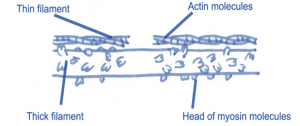Sliding filament theory
The myofibrils are an arrangement of separate units connected end on end to form long strands. These units are called sarcomeres and are the smallest contractile units of the muscle. This pattern is repeated along the whole length of the myofibril. Sarcomeres have a highly organised structure and are composed of two protein-based myofilaments:
- A thin actin filament
- A thicker myosin filament
The myosin and actin filaments run adjacent to each other, but at rest are not attached. The interaction and overlapping of these two myofilaments allows muscles to contract through the sliding filament theory.
The myosin and actin filaments run adjacent to each other but at rest are not attached. The sarcomere is the area between the two Z lines (see diagram below), the I band contains only the thin filaments of actin, the H zone contains only myosin filaments and the A band contains both actin and myosin filaments. The interaction and overlapping of these two myofilaments allows muscles to contract through the sliding filament theory. When a muscle contracts the actin and myosin slide over each other (similar to patio doors). As the actin filaments are attached to the Z lines the result is to pull the two Z lines closer together, shortening the sarcomere.
Each actin filament is composed of two components:
- Fibrous actin which provides active sites to which myosin molecules can bind during muscle contraction
- Tropomyosin and troponin molecules which during relaxation prevent the attachment of the myosin cross bridge. Calcium ions are released during innervation (nervous stimulation of the muscle tissue) from the sarcoplasmic reticulum surrounding the myofibrils, which cause the troponin to change shape and remove the inhibitory effect of the tropomysium allowing the myosin cross bridge to attach to the actin filament forming the actomyosin complex
Myosin filaments are composed of many myosin molecules, which are made up of two parts – a rod and a head. Together these form a golf-club shaped molecule. The heads of each molecule contain ATPase, an enzyme used to break down a chemical called adenosine triphosphate (ATP) which, in doing so, releases energy for muscular contraction. This energy is used to bind the myosin cross bridge onto the actin filament, thereby allowing muscular contraction.
The muscle responds to a nerve impulse by shortening. The sliding of the filaments past each other takes the form of a ratchet mechanism, whereby the myosin cross bridges continually attach, detach, reattach, and so on. It is the sweeping action of the myosin head which causes the actin filaments to be pulled towards the centre and slide past the myosin filaments. The myosin pulls the actin across so that the two filaments slide closer together, rather than either of the two filaments physically getting shorter. The action of the sliding filaments during contraction causes shortening of all sarcomeres, and therefore all muscle fibres.
When a muscle contracts 3 things can be observed:
- The I band shortens (the I band is the area in the sarcomere that contains only actin filaments)
- The A band remains the same length (the A band is the area in the sarcomere that is equal to the length of the myosin filaments)
- The H zone disappears (the H zone is the area in the sarcomere that contains only myosin filaments)
These three events can be explained by the myosin pulling the actin across so that the two filaments slide closer together, rather than either of the two filaments physically getting shorter.
The action of the sliding filaments during contraction causes shortening of all sarcomeres, and therefore all muscle fibres.


